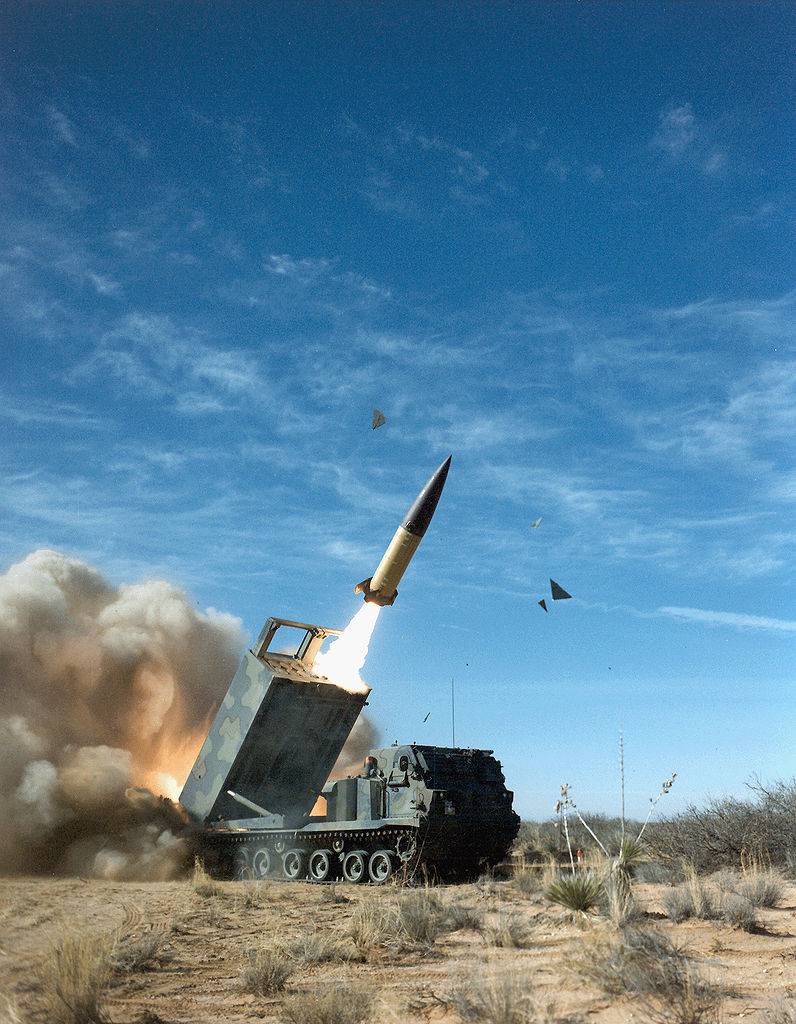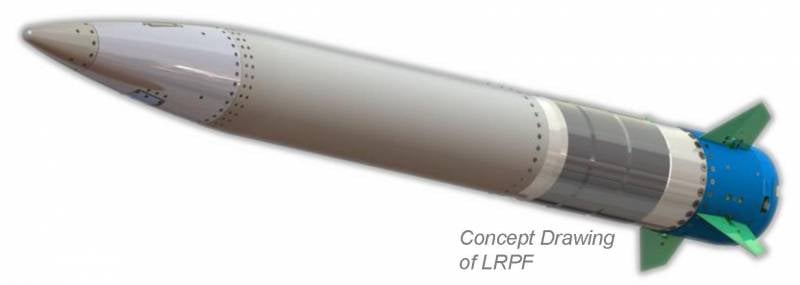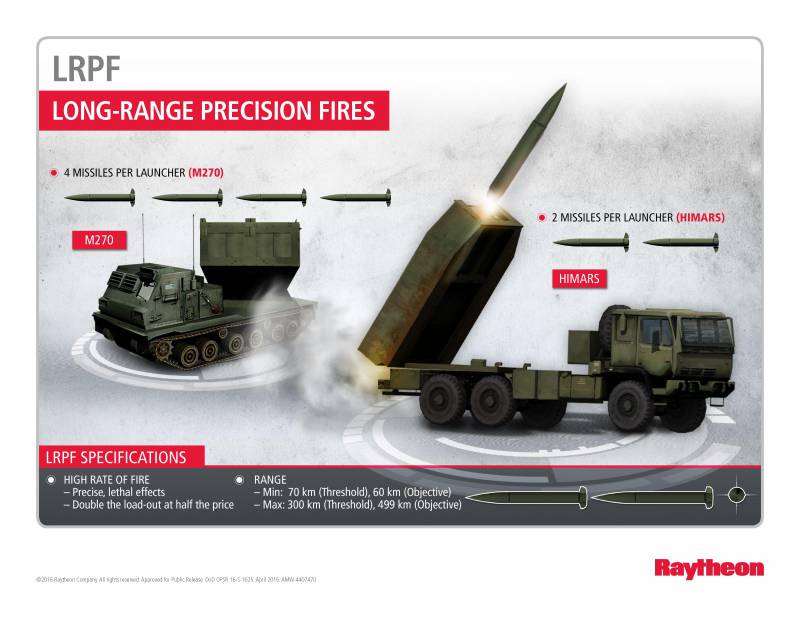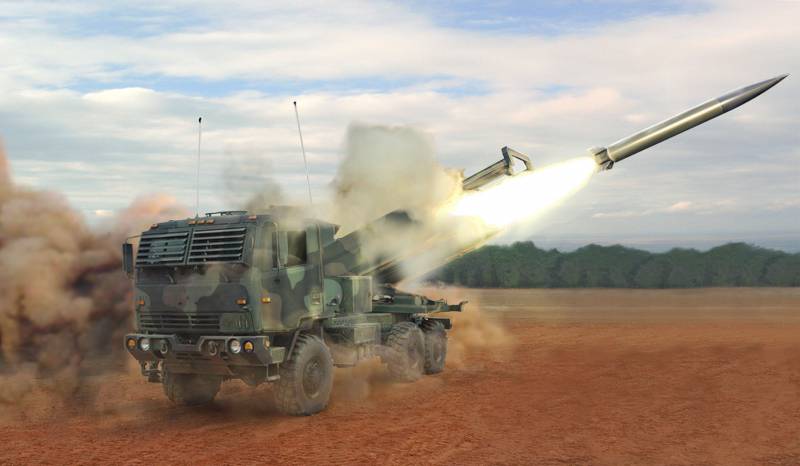LRPF, alignment on the "Iskander"
The existing ATACMS complex (Army Tactical Missile System - “Tactical Army Missile System”) is a refinement of the M270 MLRS and HIMARS multi-launch rocket launchers. The essence of this refinement was to equip the MLRS with a new guided munition with high firing range and a relatively heavy warhead. Such an approach to the creation of an operational-tactical missile system made it possible to achieve certain savings due to the absence of the need to build self-propelled launchers designed specifically for working with new missiles. In addition, greater flexibility in the use of existing and under construction equipment was provided.
Some time ago, the American military leadership came to the conclusion that it was necessary to further develop operational-tactical missile systems. The ATACMS in service can still be used by troops, but its characteristics may already be insufficient to solve existing combat missions. The result of such an assessment of the existing situation was the beginning of the LRPF (Long Range Precision Fires - “High Precision Long Range”) program. The main requirements for promising developments that should have appeared in the course of this program were an increase in the range and accuracy of shooting in comparison with existing missiles.
Several leading United States defense companies offered their vision for a promising project. The military specialists analyzed the proposed preliminary projects and made their decision. In mid-March 2016, it was announced that the Pentagon had chosen a project from Raytheon. She was entrusted with the development of advanced weapons, designed for the future replacement of existing systems. In addition, Lockheed Martin will take part in the LRPF project. She will have to perform part of the work on the creation of various components of a promising missile system.
Apparently, one of the reasons that the Raytheon project won the Ministry of Defense competition was the approach to the overall architecture of the operational-tactical missile system and the creation of new weapon versions. The authors of the new project rightly decided that the existing MGM-140 and MGM-164 missiles have limited modernization potential that does not allow to fully solve all the existing tasks. In this regard, on the basis of the available ammunition, only rockets can be made, which will be only a temporary solution. For a complete solution of the tasks, it is necessary to develop completely new weapons. In addition, the Raytheon LRPF project borrows some ideas from ATACMS. So, it is proposed to abandon the creation of a new launcher and develop a rocket, taking into account compatibility with machines M270A1 and HIMARS.

The launch of the ATACM rocket self-propelled launcher M270. Photo of Wikimedia Commons
Using similar ideas, Raytheon offered to develop a promising operational-tactical missile with enhanced characteristics that could be a substitute for the products of the ATACMS complex. According to the preliminary studies of the project, information about which was published last year, the proposed appearance of the missile complex allows for a range of at least 300 km when using the required type of warhead weighing at least 200 pounds (from 90 kg). To improve the effectiveness of the strike, it was proposed to use, first of all, the cluster warhead. In this case, it will be possible to use weapons at any time of the day, regardless of weather conditions.
Due to the use of modern technologies, materials and aggregates, it was possible to reduce the size and weight of the rocket without deteriorating the basic characteristics. In accordance with preliminary calculations, the transverse dimensions of the new LRPF rocket turned out to be such that two products could be placed in a standard container used by multiple launcher systems. Thanks to this, the M270A1 machine is able to transport and launch four new types of missiles, HIMARS - two. For comparison, ATACMS missiles have a caliber 610 mm, because of which only one unit of such weapons is placed in a standard container.
The proposed appearance of a promising missile system completely satisfied the customer, resulting in the appearance of a contract for the development of a full-fledged project. Not so long ago, at the end of August, Raytheon received another contract specifying some design details. In particular, it sets the period in 9 months during which the first results of the design work should be presented. The contract value is 5,7 million dollars. Upon completion of the deadline, the LRPF project will move to a new stage, which will lead it to the flight test phase.
For objective reasons, the company-developer of the LRPF complex is not in a hurry to publish detailed data on the technical appearance or exact characteristics of a promising rocket system. Nevertheless, at the preliminary work stage, Raytheon revealed some features of the future project, and also announced its intentions. All this information, which appeared earlier, does not allow to fully establish the appearance of the new rocket, but it does provide an opportunity to imagine what it will be at the end of the design work. Also, a certain idea of a promising product is provided by drawings depicting the possible appearance of a rocket.
In the published drawings, a promising operational-tactical missile is depicted as a product with a cylindrical body of high elongation, an ogival or conical head fairing and tail empennage based on trapezoidal planes. The dimensions of the body, for obvious reasons, are still unknown, but it is safe to say that the total length of the LRPF rocket will not exceed 4 meters. Otherwise, the ammunition simply does not fit in the volume of the standard container used by the American MLRS. The unguided rockets for the M270 and HIMARS systems have an 227 caliber mm, which allows two horizontal rows of three guides for the rockets to be placed in the container. Only one 610-mm ATACMS tactical missile fits in the same volume. Thus, to install two guides in a standard container, the LRPF rocket must have a maximum diameter of no more than 340-350 mm, and also be equipped with planes unfoldable in flight. The weight parameters of the product cannot be estimated with acceptable accuracy using only the available information.
In one of the relatively old documents on the development of operational-tactical missile systems, and previously published by Raytheon, there was a general scheme of a promising Long Range Precision Fires rocket, which may to some extent correspond to real solutions used in developing a full-fledged project. In this case, the head compartment of a promising product may be given under the control equipment, and a large volume behind it will accommodate a warhead of a cassette or other type. The large tail section, which occupies about half of the total length of the hull, is intended for installation of the engine. Apparently, again will be used solid-fuel power plant, capable of showing the required characteristics of thrust and duration of work.
According to statements by officials of direct relevance to the new LRPF project, the promising missile will be equipped with modern guidance systems that provide an advantage over existing weapons. It was also mentioned that the rocket can get an autonomous guidance system based on inertial navigation with the possibility of correction by GPS signals. In theory, such control systems make it possible to provide a very high accuracy to a ballistic missile: a circular probable deviation can be within a few meters.
The main type of payload of operational-tactical missiles of the ATACMS family are cluster warheads equipped with various types of submunitions. It is possible to use high-explosive fragmentation, anti-tank and other combat elements, in large quantities placed in a single body. Some data on the LRPF project suggests that when creating a new operational-tactical missile, combat units similar to the existing ones will be used.
Early reports on the development of the new rocket featured range parameters at the level of existing ATACMS products. According to these data, the promising missile should be able to hit targets at ranges from 75 to 300 km. To date, new information has appeared. Now it is argued that the LRPF rocket will be able to hit targets at ranges up to 500 km, which will give it a significant advantage over existing complexes of American and foreign development.
According to the representatives of the developer, the promising missile system will retain the main goals and objectives of its predecessors. Launchers with LRPF missiles will have to attack stationary ground targets, such as airfields, military infrastructure facilities, troops in areas of concentration, etc. For obvious reasons, the use of such weapons against troops on the march or on the front line looks inappropriate. By increasing the maximum firing range in comparison with the existing ATACMS system, combat effectiveness and application flexibility can be improved.
An important advantage of the new project should be maximum unification with existing systems and the use of finished equipment. It is assumed that operational-tactical missiles LRPF will be supplied in standard transport-launch containers, similar to those used with other ammunition for the American MLRS. This will allow the use of existing weapons on the armament of the equipment, namely the M270A1 and HIMARS vehicles. Such an approach will allow one of the main advantages of the ATACMS complex to be preserved in the form of the versatility of combat vehicles, while simultaneously enhancing the characteristics.
It is also planned to use existing ideas and technologies borrowed from other projects. In particular, it was mentioned that in developing the Long Range Precision Fires rocket, some developments will be used on the SM-3 and SM-6 anti-aircraft systems designed for the naval forces. Despite the different purpose of the initial projects, some ideas and solutions from them can be useful in creating an operational-tactical complex.

The role of the LRPF complex in the structure of rocket troops and artillery. Outline of the presentation on the development of the MLRS
The company-developer will need several years to perform all the necessary work. By the end of this decade, it is planned to complete design work and begin testing a new complex. The adoption of the LRPF system is planned for the first half of the twenties. In the absence of any serious problems, according to Raytheon’s early estimates, the first production missiles of the new type can be transferred to the troops in 2022-23.
On the basis of the available data, it can be assumed that by the middle of the next decade the ground forces of the United States will begin to upgrade their arsenals and master the new weapons. The result of these processes will be quite original. Relatively old, albeit modernized, combat vehicles will be able to use both unguided rockets of several types, created in the eighties of the 20th century, and the latest operational tactical ones. From the point of view of tactical and technical characteristics, this will allow the same equipment, depending on the assigned combat missions, to attack targets within a radius of several hundred kilometers, using suitable ammunition. Such versatility in the use of combat vehicles in combination with the enhanced characteristics of LRPF missiles should give the troops certain advantages.
At the moment, the project Long Range Precision Fires is in the early stages of design. Raytheon and the US military are working on the common features of a promising rocket system and the formation of its exact appearance. Some of the most general information has already been announced that allows making certain assumptions. It will take several years for the developer to complete the current work, after which the flight tests of the missiles will begin, on the results of which the Pentagon will make its decision. At the same time, according to some data, the possibility that some new developers will be attracted to the LRPF program, who will have to create their own versions of the rocket, is not excluded. Thus, the actual results of current work will become known only in a few years when the project reaches the test. However, new project progress messages may appear at any time.
On the materials of the sites:
http://raytheon.com/
http://dtic.mil/
http://janes.com/
http://militaryaerospace.com/
http://nationalinterest.org/
http://rbase.new-factoria.ru/
2015 presentation of the year dedicated to the development of multiple launch rocket systems:
http://dtic.mil/ndia/2015PSAR/Stephens.pdf



Information